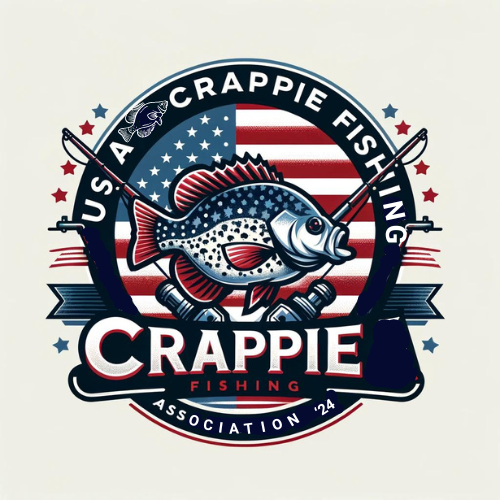In this article, I will share my personal journey from being a beginner angler to becoming a crappie fishing hero. I’ll take you through my embarrassing start, the mistakes I made, and how I turned my fishing endeavors around to achieve success. Join me as I share valuable crappie fishing tips, techniques, and motivation that will help you on your own fishing journey.
Being a beginner angler can be challenging. I vividly remember the days when my fishing trips resulted in nothing but frustration and disappointment. I would cast my line, hoping for a bite, but it seemed like the fish were mocking me from the deep waters. But I didn’t let the embarrassing start deter me; instead, I used it as fuel to improve and learn.
With determination and a thirst for knowledge, I delved into the world of crappie fishing. I studied different techniques, learned about the habits and behavior of crappie, and sought advice from experienced anglers. Gradually, my skills began to improve, and I started experiencing small victories on the water.
Over time, I fine-tuned my fishing techniques and made adjustments to my setup based on trial and error. I discovered the right rod length, the perfect reel, and the ideal fishing line for crappie fishing. I experimented with various lures and baits and honed my casting skills. And little by little, my fishing success began to soar.
The key to my turnaround was not only the technical aspects of fishing but also the motivation and passion I had for the sport. I realized that fishing is not just about catching the biggest fish or boasting about your skills—it’s about the journey itself. It’s about the moments when nature surrounds you, when you feel at peace, and when you connect with the water and the fish.
So, if you’re a beginner angler feeling discouraged by your initial struggles, I encourage you to keep going. Embrace the challenges, learn from your mistakes, and never lose sight of your fishing motivation. With time, patience, and dedication, you too can go from zero to crappie hero.
Key Takeaways:
- Even with an embarrassing start, it’s possible to turn your fishing endeavors around and achieve success.
- Invest time in studying different crappie fishing techniques and learn about their habits and behavior.
- Ensure your fishing setup is tailored to crappie fishing, from the rod length to the reel and fishing line.
- Experiment with different lures and baits to find what works best for attracting crappie.
- Remember, fishing is not just about the catch—it’s about the journey, the connection with nature, and the inner peace it brings.
Understanding Crappie Fishing Setup Basics
Before diving into the details of creating the ultimate crappie fishing setup, it’s important to understand the basics. A successful crappie fishing setup requires finding the right balance between sensitivity and strength. This includes choosing the right rod length, material, and reel. Additionally, understanding gear ratio and the drag system of your reel is crucial. Selecting the appropriate fishing line is also important for a successful crappie fishing setup.
When it comes to crappie fishing essentials, the key components of a well-rounded setup are the rod, reel, and fishing line. Each of these elements contributes to the overall performance and success of your fishing endeavors.
Choosing the Right Rod
The crappie fishing rod is the foundation of your setup, providing the sensitivity and strength needed to detect subtle bites and reel in the fish. Consider the following factors when selecting a crappie fishing rod:
- Rod length: Opt for a rod length between 7 to 9 feet for better casting accuracy and maneuverability.
- Rod material: Graphite rods are preferred for their lightweight construction and increased sensitivity, allowing you to feel even the slightest nibble.
- Rod power: Select a rod with a power rating of medium-light to ultra-light for optimal performance with crappie.
Recommended crappie fishing rod brands include Ozark and ACC, known for their quality construction and performance on the water.
Choosing the Right Reel
The crappie fishing reel is responsible for smooth line retrieval and effective drag control. Pay attention to the following aspects when choosing a reel for your setup:
- Gear ratio: Opt for a reel with a moderate gear ratio, around 6:1, to achieve a balance between speed and power during retrieval.
- Drag system: Look for a reel with a smooth and reliable drag system that can handle the fight of a crappie without causing the line to break.
Reputable brands like Daiwa offer a variety of crappie fishing reels designed with the angler’s needs in mind.
Selecting the Right Fishing Line
The fishing line is the direct connection between you and the fish. It’s crucial to choose the right line that suits your fishing style and the conditions you’ll be fishing in. Consider the following factors:
- Line type: Monofilament, fluorocarbon, and braided lines are popular choices for crappie fishing.
- Fishing line test: Opt for lines in the 4 to 8-pound test range for crappie fishing, striking a balance between strength and visibility.
- Line diameter: Thinner lines sink faster and offer a more natural presentation, making them ideal for crappie fishing.
Now that you have a better understanding of the crappie fishing setup basics, you’re ready to move on to more advanced techniques and strategies for catching crappie. Remember, the right rod, reel, and fishing line can make all the difference in your fishing success.
Crafting the Ideal Crappie Fishing Rod
When it comes to crappie fishing, having the right fishing rod can make all the difference in your success. Crafting the ideal crappie fishing rod involves considering several important factors such as rod length, power, sensitivity, and material.
1. Rod Length
Choosing the right rod length is crucial for accurate casting and optimal control when reeling in crappie. A rod length of 7 to 9 feet is recommended, as it provides the necessary reach and leverage to handle different fishing situations.
2. Rod Power
The power of the rod refers to its strength or flexibility. For crappie fishing, a rod with medium-light to ultra-light power is ideal. This allows for better sensitivity and hook-setting, while still providing enough backbone to handle the fight of a crappie.
3. Sensitivity
Sensitivity is a key feature to consider when selecting a crappie fishing rod. A rod with high sensitivity allows you to feel even the slightest nibble or bite, increasing your chances of detecting crappie strikes and making quick, accurate hooksets.
4. Material
The material of the fishing rod plays a crucial role in its performance. Graphite rods are highly recommended for crappie fishing due to their lightweight nature and increased sensitivity. They offer better control and responsiveness, allowing you to detect subtle vibrations and movements underwater.
Recommended Rods
- Ozark XYZ Crappie Rod
- ACC Pro Angler Crappie Rod
These brands are known for their quality craftsmanship and performance, making them popular choices among experienced crappie anglers.
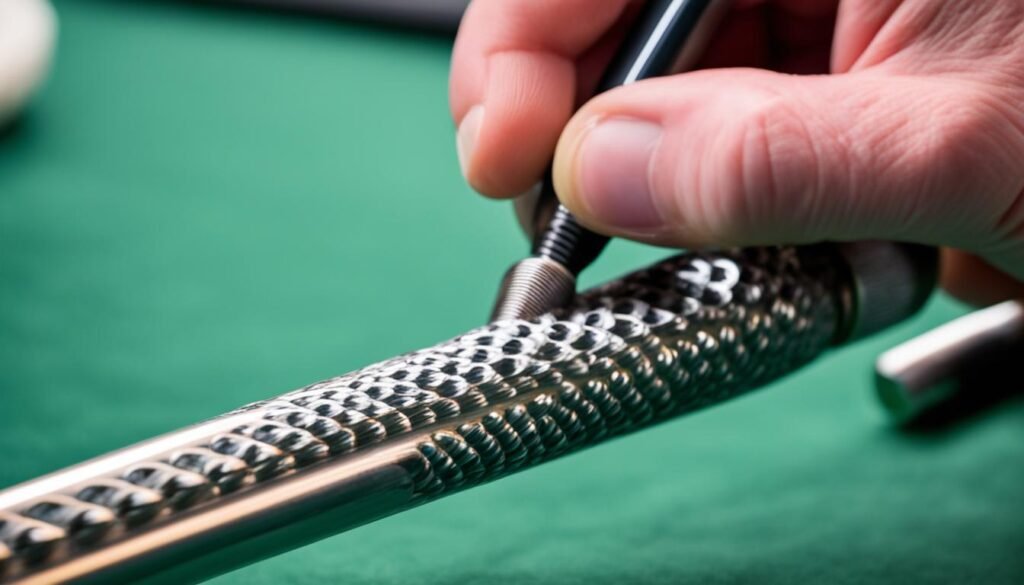
Having a well-crafted crappie fishing rod is essential for a successful fishing expedition. Remember to consider factors such as rod length, power, sensitivity, and material when selecting your rod. With the right rod in your hands, you’ll be well-prepared to conquer your next crappie fishing adventure.
Crafting the Perfect Reel for Crappie Fishing
When it comes to crappie fishing, selecting the perfect reel is essential for a successful angling experience. A well-crafted reel can make a significant difference in your ability to catch and reel in crappie efficiently. In this section, we will explore the key factors to consider when choosing a crappie fishing reel, including gear ratio, drag system, and reel selection.
Gear Ratio
The gear ratio of a fishing reel refers to the number of times the spool rotates with each complete turn of the reel’s handle. For crappie fishing, a moderate gear ratio of around 6:1 is preferred. This gear ratio allows for a steady retrieve speed, providing you with the control and precision needed to entice crappie and keep them on the line.
Drag System
The drag system of a reel determines the amount of resistance a fish feels when pulling on the line. A smooth and consistent drag system is crucial for handling crappie, as they are known for their quick and unpredictable movements. Opt for a reel with an efficient drag system that allows for easy adjustment and provides the right amount of resistance to tire out crappie without risking line breakage.
Reel Selection
When selecting a crappie fishing reel, it’s important to consider both the functionality and durability of the reel. Look for reels from reputable brands, such as Daiwa, Shimano, or Abu Garcia. These brands are known for their high-quality reels specifically designed for different fishing techniques, including crappie fishing. Take into account factors such as reel weight, line capacity, and overall construction to ensure a reel that suits your specific needs.
Overall, crafting the perfect reel for crappie fishing involves careful consideration of the gear ratio, drag system, and reel selection. By choosing a reel that complements your rod and fishing style, you can enhance your chances of success on the water. Explore options from trusted brands like Daiwa to find a reel that meets your requirements and helps you reel in those prized crappie.
Exploring Line Options for Your Crappie Fishing Setup
The fishing line is a crucial component of your crappie fishing setup. Choosing the right line type is essential to maximize your chances of success on the water. Here, I will discuss three popular line options for crappie fishing: monofilament, fluorocarbon, and braided lines.
Monofilament Line
Monofilament line is a versatile and widely-used choice for crappie fishing. It offers a good balance of visibility and strength, making it suitable for various fishing conditions. Monofilament lines are available in different pound test ratings, indicating their strength or resistance to breaking. For crappie fishing, monofilament lines in the 4 to 8-pound test range are recommended.
Fluorocarbon Line
Fluorocarbon line is known for its low visibility and exceptional sensitivity. It is less likely to be detected by wary crappie, increasing your chances of getting a bite. Fluorocarbon lines also have low water absorption, making them more durable and resistant to damage. However, fluorocarbon lines may be more expensive compared to monofilament.
Braided Line
Braided line, made of woven fibers, is incredibly strong and has a small diameter compared to monofilament and fluorocarbon lines of the same pound test rating. Its high strength-to-diameter ratio allows for longer casting distances and better sensitivity, allowing you to detect even the slightest bites. However, braided lines are highly visible in the water, which can be a disadvantage in clear or calm conditions.
When selecting a fishing line, it’s important to consider the line diameter as well. Thinner lines tend to sink faster, making them ideal for fishing at deeper depths. They also provide a more natural presentation to crappie. However, thinner lines may have lower overall strength and may be more difficult to handle.
Ultimately, the choice of fishing line depends on your preferences and the specific fishing conditions you encounter. It’s always a good idea to experiment with different line types and test their performance in different scenarios. By doing so, you’ll be able to find the line that works best for your crappie fishing setup.
| Line Type | Advantages | Considerations |
|---|---|---|
| Monofilament | Good visibility and strength balance | May not be as invisible as fluorocarbon |
| Fluorocarbon | Low visibility, exceptional sensitivity | Higher cost compared to monofilament |
| Braided | High strength, small diameter | High visibility in clear or calm conditions |
Deciphering Crappie Lures and Baits for Your Setup
When it comes to crappie fishing, using the right lures and baits can make all the difference. There are several options available, each with its own advantages and effectiveness in attracting crappie. Popular choices for crappie lures and baits include jigs, crankbaits, and spinners.
Jigs: One of the most versatile and effective lures for crappie fishing, jigs are designed to mimic the movement of natural prey, such as insects and small baitfish. Their lifelike action and profile make them irresistible to hungry crappie. Jigs come in various sizes, shapes, and colors, allowing you to experiment and find the perfect combination that entices the fish. When using jigs, consider factors like water depth, current, and the preferences of the crappie you’re targeting.
Crankbaits: Crankbaits are another popular choice among anglers targeting crappie. These lures are designed to imitate small fish, with their diving lips allowing them to reach different depths in the water. Crankbaits are particularly effective when crappie are feeding aggressively. By varying the speed of retrieval and the depth at which you fish, you can trigger strikes from hungry crappie.
Spinners: Spinners are effective lures that feature a rotating, flashy blade that simulates the movement of a small fish or insect. The spinning blade creates vibrations and visual cues that attract crappie, making them a great choice for both aggressive and neutral fish. Spinnerbaits can be retrieved at different speeds and depths to find the most effective presentation.
Color Selection: Crappie can be finicky when it comes to color selection, and what works on one day may not work on another. It’s essential to experiment with different colors to find what crappie are responding to. Some anglers swear by bright and vibrant colors, while others have success with more natural and subtle shades. Remember to consider water clarity, light conditions, and the behavior of crappie in your specific fishing location when selecting lure colors.
Understanding different lure rigging techniques is also important for success in crappie fishing. By learning how to properly rig your chosen lures, you can enhance their action and increase your chances of enticing crappie to bite. Whether it’s adding trailers to jigs or adjusting the hooks on crankbaits, mastering these techniques can give you an edge on the water.
So, when it comes to crappie lures and baits, don’t be afraid to try different options, colors, and rigging techniques. Remember, what works for one angler may not work for another, so be open to experimentation and adapt your approach based on the conditions and the behavior of the fish. With the right combination of lures, baits, and techniques, you’ll be well on your way to landing more crappie.
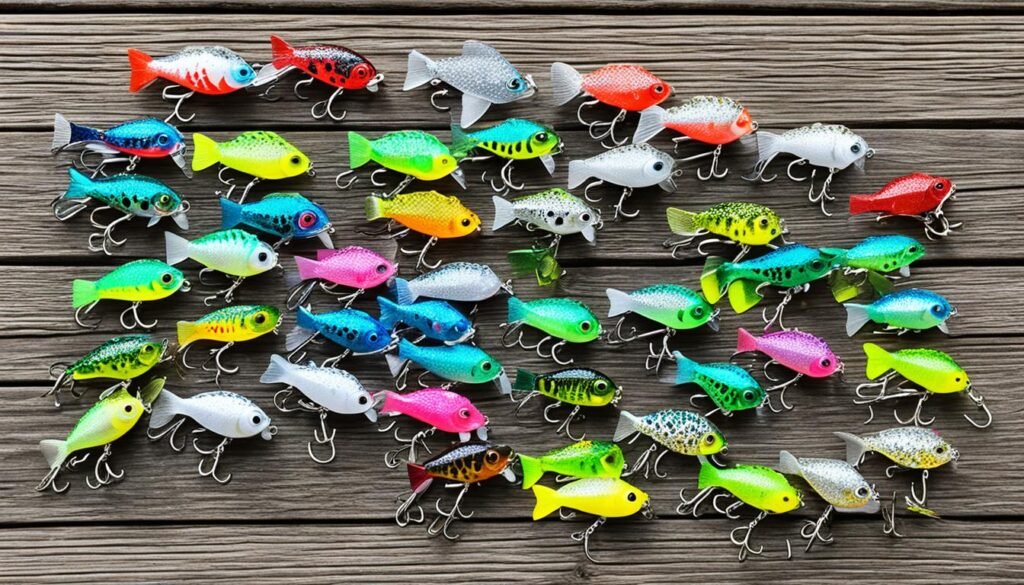
Crafting the Ideal Tackle for Different Techniques
When it comes to crappie fishing, versatility is key. The right tackle can make all the difference in your success on the water. It’s important to consider the specific techniques you intend to use and select tackle that is well-suited for each approach. Whether you prefer vertical jigging or trolling, taking into account cover and structure considerations, and using the appropriate crappie fishing tackle will greatly increase your chances of landing that prized catch.
Vertical Jigging: Tackle Considerations
Vertical jigging is a popular technique for targeting crappie, especially in deeper water. When crafting your tackle for vertical jigging, consider the following:
- Choose a jigging rod that provides sensitivity and flexibility for detecting even the slightest nibble.
- Opt for a light to medium power rod that allows for accurate presentation and control.
- Pair the rod with a reel that has a smooth drag system to handle the sudden bursts of energy exhibited by crappie.
- Select a fishing line with low visibility, such as fluorocarbon, to avoid spooking the fish.
- Use jigs in various colors and sizes to experiment and find what the crappie are most active on.
Trolling: Tackle Considerations
Trolling is another effective technique for crappie fishing, especially when covering larger areas of water. Consider the following when selecting your trolling tackle:
- Choose a longer rod, around 8 to 10 feet, to cover more water and provide better line control.
- Opt for a medium power rod with a slightly faster action for better hooksets when trolling.
- Select a reel with a higher gear ratio for a faster retrieve, enabling you to cover more ground.
- Use lighter line, such as monofilament or braided, to reduce drag and allow your baits to reach the desired depth.
- Experiment with different trolling baits, such as crankbaits or spinners, to find what triggers the crappie’s feeding response.
Cover and Structure Considerations
When fishing around cover and structure, it’s important to adjust your tackle accordingly to increase your chances of success. Here are some considerations:
- Use weedless jigs or baits to minimize snagging when fishing in areas with heavy cover.
- Opt for lighter tackle to minimize disturbance when presenting your bait near structure.
- Choose a rod and reel combo that allows for accurate and controlled casts in tight spaces.
- Experiment with different line weights to find the perfect balance between strength and stealth.
By crafting the ideal tackle for different techniques, taking into account the versatility required for crappie fishing, vertical jigging, trolling, and cover and structure considerations, you’ll be well-equipped to tackle any fishing situation. Remember to adjust your tackle based on the specific fishing technique and environment you are targeting for the best results.
Budget-Friendly Crappie Fishing Setup Options
When it comes to crappie fishing, you don’t need to break the bank to get a quality setup. There are affordable options available that offer excellent performance and value for money. Here are some budget-friendly choices for rods, reels, and fishing lines that will help you save without compromising on quality.
Affordable Rods
Brands like Ugly Stik and Shakespeare are well-known for producing affordable rods that deliver decent sensitivity and strength. These rods are designed to handle the specific demands of crappie fishing and are available in a range of lengths and power ratings. With an affordable rod, you can confidently cast your line and feel even the slightest nibble from crappie lurking below the surface.
Affordable Reels
Pairing your budget-friendly rod with a reliable and affordable reel is essential for a well-rounded crappie fishing setup. The Daiwa BG series is a popular choice among budget-conscious anglers. These reels offer a smooth drag system, solid construction, and a gear ratio suitable for crappie fishing. With an affordable reel, you can retrieve your line with ease and reel in those prized crappie.
Budget-Friendly Line Choices
Choosing the right fishing line is crucial for success in crappie fishing. While there are many high-end options available, there are also budget-friendly alternatives that perform admirably. Trilene Sensation and PowerPro are examples of affordable lines that still provide the necessary strength and durability to handle crappie. These lines come in various thicknesses, allowing you to select the most suitable diameter for your fishing conditions.
By opting for these budget-friendly options, you can enjoy your crappie fishing adventures without putting a strain on your wallet. Remember, quality doesn’t always have to come at a high price. With the right affordable rod, reel, and fishing line, you can embark on a budget-friendly crappie fishing journey without compromising on performance.
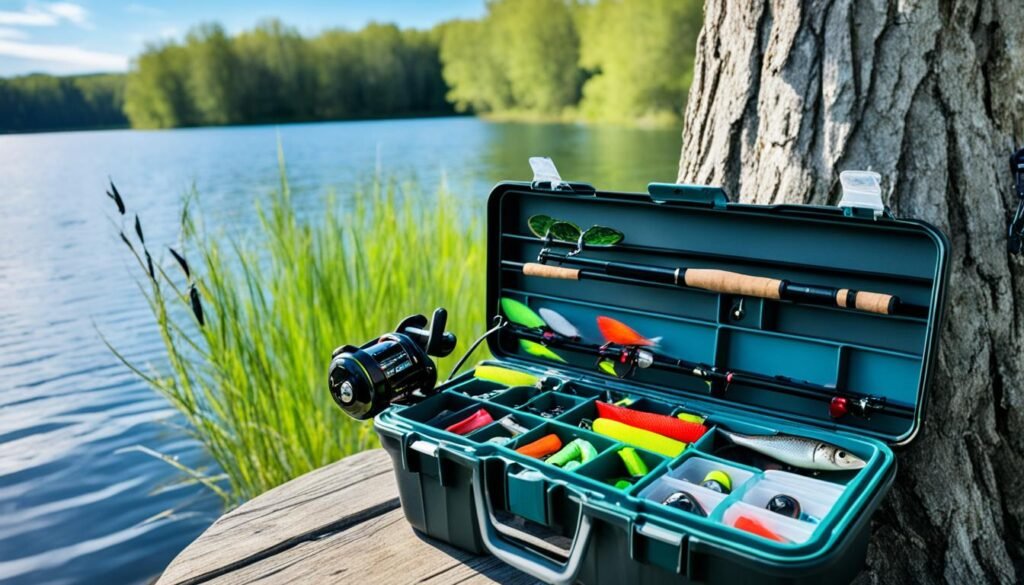
Researching Local Fishing Spots and Ideal Freshwater Environments
As I embarked on my crappie fishing journey, I quickly learned the importance of researching local fishing spots and finding the ideal freshwater environments. To maximize your chances of a successful angling experience, it’s crucial to understand the unique advantages offered by different lakes, rivers, and ponds.
Finding Local Fishing Spots
One of the best ways to discover local fishing spots is by utilizing online resources and participating in local fishing forums. These platforms provide valuable insights and recommendations from experienced anglers who have explored various water bodies in your area. From hidden gems to well-known hotspots, these online communities can guide you towards the best fishing locations.
The Beauty of Freshwater Environments
Freshwater environments, such as lakes, rivers, and ponds, each have their own characteristics and factors to consider when planning your fishing trips. Let’s explore what makes each of these environments special:
- Lakes: Lakes offer vast open spaces and can provide ample room to explore and find the perfect fishing spot. Depending on the size and depth of the lake, you can expect to encounter various fish species, including crappie. The calm waters of lakes also make them suitable for fishing with different techniques.
- Rivers: Fishing in rivers brings a dynamic and ever-changing experience. Rivers offer flowing currents, which can attract and concentrate fish. Look for areas near structures like fallen trees or submerged rocks, as these often provide shelter for crappie and other fish. Pay attention to the water movement and try different depths and eddies along the riverbank to increase your chances of success.
- Ponds: Ponds are smaller bodies of water that can be found in rural and residential areas. They offer a more intimate fishing experience, where you can focus on specific areas and study the behavior of crappie and other fish. Ponds often have abundant vegetation, which can attract insects and small prey, making them prime feeding grounds for crappie.
By understanding the characteristics of these freshwater environments, you can strategically plan your fishing trips and adapt your techniques accordingly.
Crappie Fishing: Temperature and Fish Behavior
Catching crappie requires understanding their behavior and how it changes with water temperature. During different seasons, crappie tend to move to different areas of the water body. For example, during spring, they may move closer to the shore for spawning, while in summer, they might seek deeper, cooler waters. By researching and monitoring water temperature changes, you can predict the optimal time to fish for crappie in your local fishing spots.
Additionally, observing fish behavior in different environments can give you valuable insights. Pay attention to where crappie congregate, such as around submerged structures, underwater vegetation, or near the edges of drop-offs. Understanding their preferred habitats and feeding patterns will help you narrow down the best spots to target.
Researching local fishing spots and understanding the ideal freshwater environments for crappie fishing will greatly enhance your chances of success. With the right knowledge and preparation, you’ll be well on your way to becoming a crappie fishing hero.
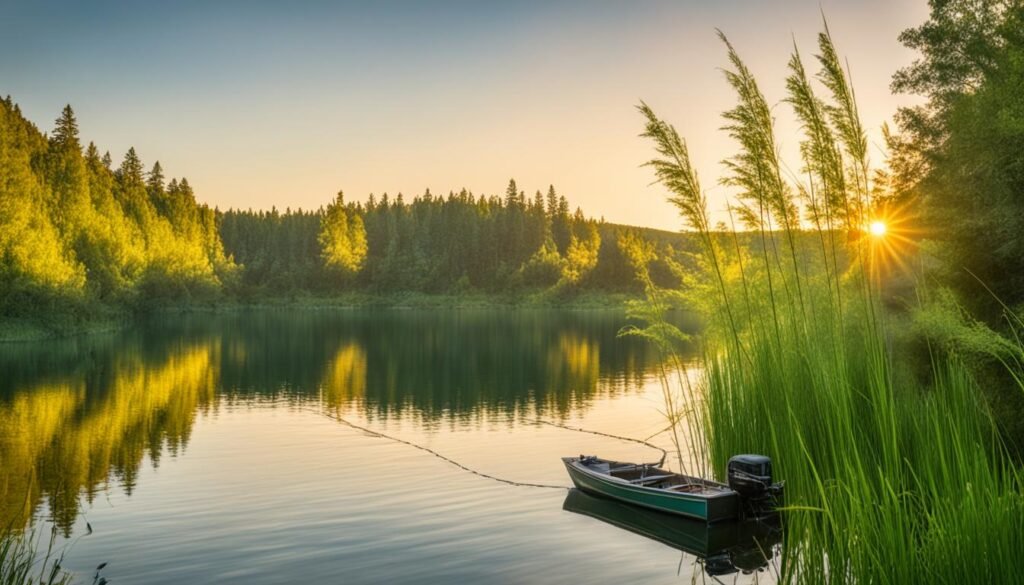
Casting Basics, Patience, and Observation
When it comes to successful fishing, mastering casting basics is essential. A good cast requires a proper grip and a smooth release of the fishing line. These two elements ensure accuracy and distance, increasing your chances of attracting the attention of crappie.
Additionally, fishing requires patience. It might take some time before you feel a bite on your line, but patience is indeed a virtue in the world of fishing. Stay focused and persistent, and eventually, your patience will be rewarded with a catch.
To optimize your fishing approach, it’s crucial to observe fish behavior and adapt your techniques accordingly. Keep an eye on the water’s surface, take note of any movement or splashes, and look for signs of feeding activity. By observing fish behavior, you can gauge their preferences and adjust your bait or lure presentation to make it more enticing.
Remember, fish behavior can be influenced by factors such as weather, water temperature, and time of day. Pay attention to the details and be willing to adapt your approach.
Key Takeaways:
- Master the basics of casting to improve your accuracy and distance.
- Practice patience and stay persistent while waiting for a bite.
- Observe fish behavior to understand their preferences and adapt your techniques accordingly.
Conclusion
My crappie fishing journey has been a rollercoaster ride, filled with both triumphs and challenges. As a beginner angler, I started off with embarrassing moments and countless missed bites. However, by arming myself with the right knowledge and equipment, I transformed my fishing experience into a remarkable success story.
Understanding the basics of crappie fishing setup, including the right rod, reel, and line, was crucial in improving my chances of landing that prized catch. Crafting the ideal combination of sensitivity and strength allowed me to feel even the slightest nibble and reel in crappie with confidence.
But it wasn’t just about the gear. Patience, observation, and adaptability played significant roles in my fishing journey as well. I quickly realized the importance of being patient and waiting for the perfect moment, as crappie are known to test even the most persistent anglers. By observing their behavior and adjusting my techniques accordingly, I maximized my chances of success.
As I reflect on my journey, I’m reminded that fishing is not just a hobby; it’s a passion that requires dedication and motivation. Each trip to the water brings its own set of challenges and rewards, making every catch that much more satisfying. So, fellow anglers, take these tips to heart, embrace the ups and downs of your own crappie fishing journey, and let your determination drive you towards becoming a crappie fishing hero.
